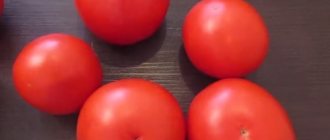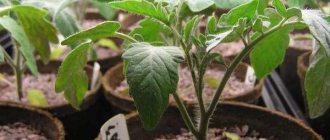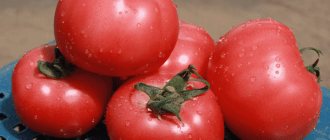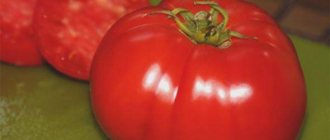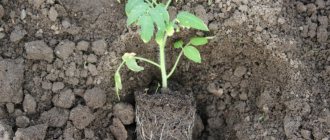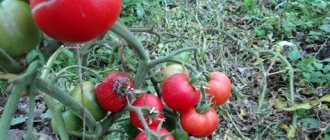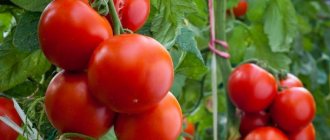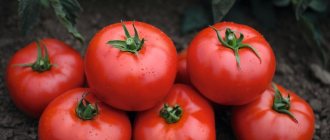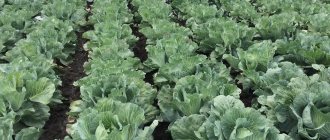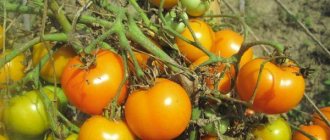Tomato Wolverine F1 is a high-quality result of Dutch selection. In addition to its high productivity, the hybrid is resistant to diseases.
| Height | Landing location | Ripening time | Fruit color | Fruit size | Origin | Fruit shape |
| Tall | Greenhouse, Open ground | Mid-season | Reds | Average | Hybrid | Flat-round |
Tomato Wolverine
photo author Svetlana Kunakovskova
Description and characteristics of tomato Wolverine F1, reviews, photo of the bush
Mid-season, determinate, productive hybrid from Holland. Recommended for growing in greenhouses and open ground. The period from germination to the beginning of ripening is 120-125 days.
The bush is medium-leaved, up to 1.5 meters high in the greenhouse, lower in the greenhouse. Requires tying to the support and pinning. The best result was obtained when forming a bush of 2-3 stems.
Basic qualities of fruits
The fruits are round, smooth, of medium density, red in color at maturity, weighing 150-200 grams. These tomatoes are suitable for fresh salads and processing.
The hybrid is resistant to verticillium, fusarium, TMV and gray leaf spot.
Originator : Syngenta.
Features of growing Wolverine tomatoes, planting and care
Sowing seeds for seedlings is carried out 55-60 days before the intended planting in the ground. Seedlings dive at the stage of two true leaves. When planting seedlings in a permanent place per 1 sq. It is recommended to place up to 4 plants per meter of land.
Further care for tomatoes consists of timely watering, fertilizing with complex mineral fertilizer, pinching and preventive measures to protect against diseases and pests.
When growing tomatoes in a greenhouse, we recommend installing a drip irrigation system - this will save your time and effort, as well as increase plant productivity and reduce the risk of late blight.
If you grew Wolverine tomatoes, please write what you liked about this hybrid and why you were disappointed. Do you consider it fruitful? Will you grow it again? Briefly describe the advantages and disadvantages of this tomato in your opinion. If possible, attach a photo of these tomatoes to your comment. Thank you!
Your reviews of the Wolverine tomato and additions to the description will help many gardeners evaluate this hybrid objectively and decide whether it is worth planting or not.
Storage rules
Preserving tomatoes correctly is no less important than growing them correctly.
In most cases, fruits are stored:
Features of storage in the refrigerator
In fact, the refrigerator is not the best place to store Wolverine. This is due to unsuitable low temperatures and constant dewetting of tomatoes.
If suddenly there is an urgent need to store tomatoes in the refrigerator, it is best to place them in a special “freshness zone”. In this compartment, the fruits will remain fresh for 3-4 weeks.
Features of storage on the balcony
A loggia is a good place to store fruits, because recently more and more apartment owners are trying to close and insulate their balconies, thereby creating good conditions for storing them.
In this case, the tomatoes must be wrapped in paper and placed in a container.
It is worth remembering that the temperature on the balcony can change. Care should be taken to maintain the temperature in advance.
Features of storage in the basement and cellar
You can’t just leave the fruits in the basement or cellar - the room needs to be prepared. To do this, it needs to be dried and insulated.
Tomatoes should be stored in boxes, with sawdust sprinkled between them. This is necessary to absorb excess moisture.
By maintaining a temperature of +10 degrees in the basement, you can be sure that the harvest will last for at least 3 months.
Description of the Wolverine tomato: characteristics of the fruit, pest control
Wolverine tomatoes are the result of the work of breeders. Tomatoes are suitable for growing exclusively in greenhouse conditions. Some gardeners claim that the variety can be adapted to open ground, however, exclusively in the southern regions of the CIS countries. Tomato Wolverine F1 is a very heat-loving plant. The culture is not able to cope with the slightest cold.
Description of the variety
Speaking about the description of the variety, first of all it should be noted that the hybrid has an average ripening speed. From seed germination to the moment the first fruit is picked, about 4 months should pass. There are a huge number of tomatoes that depend on a lot of heat, however, it is Wolverine that is most popular among gardeners.
Characteristics of tomato Wolverine, variety yield
The Wolverine tomato is a hybrid and belongs to the category of mid-season plants with determinate bushes. Fruits can be grown both in protected greenhouse conditions and in open ground. It should be remembered that even the shortest cold snap can lead to the loss of the crop being grown.
Hybrid characteristics
The bushes grow to 0.8 - 1.2 m in height and do not need to be pinched at the tops. The density of green foliage is average. The plants themselves require tying to additional supports and pinching side shoots. The growing season takes about 120 - 125 days from the moment the first seedlings appear. Forming a bush with 2 - 3 stems is the best option for obtaining a full harvest with a balanced taste.
The grown fruits are distinguished by their round shape with barely noticeable ribbing and a rich red color at the time of full ripening. The average weight of tomatoes is 150 - 200 g. The harvest is used both fresh and for processing, for example, in the preparation of juices and sauces. With proper care of the bushes, you can expect to receive about 2.5 - 3 kg of tomatoes from one bush. You can plant no more than 4 - 5 plants per 1 sq.m of plot with loose, fertile soil. The taste of the rather dense and juicy pulp is characterized as sweet and sour.
The peel is thin and dense at the same time, which reliably prevents cracking of the fruit, as well as its spoilage due to long-term transportation. Thanks to this feature, fruits can be grown not only for personal food use, but also for sale.
Grown tomatoes are also suitable for canning.
Features of cultivation
Sowing of seeds must be carried out 65 - 70 days before the planned planting of seedlings on permanent soil. If the seeds are sown in a common container, the distance between the holes should be about 2 - 3 cm. This will minimize damage to the root systems during the picking process. The depth of the holes should be about 0.7 - 1.2 cm. The soil itself requires regular watering without the formation of puddles and stagnation of water. The container with seeds should be in a warm, protected place with a temperature of about 24 - 27 degrees Celsius.
Until the first shoots appear, the container is covered with transparent glass or film, which creates an additional greenhouse effect. From the moment the first shoots appear, the shelter should be completely removed. Two weeks before the planned transplantation of seedlings, they should be taken out into the fresh air for some time. Thus, the plants harden. It is worth planting on permanent soil only after spring night frosts have completely stopped.
In this case, the soil should warm up to at least 16 - 18 degrees.
During the growing process, it is extremely important to promptly:
- watering plants using warm, settled water;
- three or four times feeding of bushes with mineral and organic fertilizers (alternately);
- weed removal;
- loosening the soil;
- mulching the soil during the hottest summer days;
- tearing off the lower foliage so that the green tops do not come into contact with the ground and deteriorate.
Regularity also requires a careful inspection of plants for possible damage, for example, brown spots, which indicates the onset of the disease.
An equally important point in growing tomatoes is the acidity level of the soil used. If it is increased, then the bushes will not be able to grow and develop normally, and fruits grown in a small harvest will most likely have altered taste characteristics. The soil must have neutral acidity, so it is recommended to treat it with sifted wood ash or lime (chalk) with the obligatory digging of the soil. It is best to carry out such work after harvesting and removing all remaining particles in the soil, which can also become sources of disease for the next crop.
Diseases and pests
The hybrid is resistant to damage from verticillium, fusarium and gray leaf spot. Viruses from the TMV group are also not dangerous to plants. To avoid damage to the bushes by any other diseases, it is enough to follow the regime of watering and feeding tomatoes. As an additional preventive measure, an infusion of nettle and comfrey can be used, which is added to the general nutritional complex.
One of the important misconceptions of inexperienced gardeners concerns the desire to fertilize the soil as much and as often as possible. An excessive amount of applied fertilizer is fraught with the accumulation of nitrogen, which provokes the growth of leaves and side shoots in the bushes, rather than the appearance of new ovaries of future fruits.
To prevent possible infection of bushes with spider mites or some other disease, you can spray the plants with a soda solution. To do this, take 250–300 g of dry matter per 8–9 liters of water. Treatment is carried out using a spray bottle. The first spraying can be carried out only two weeks after planting the seedlings in the ground. Mandatory repetition - after a week break.
Reviews
Vladislava Igorevna, 43 years old Hybrid Wolverine, however, is very thermophilic and can stop further development of fruits with the unexpected onset of sudden cold snaps. The bushes grow quite low, but tying up the clusters may be necessary, especially during the period of fruit growth and ripening.
Vasily Ivanovich, 59 years old The soil for growing a hybrid must be fertilized and loose. It is better to use special store-bought mixtures for this or prepare them yourself. In the latter case, it is recommended to take equal parts of ordinary garden soil, peat, manure or compost and coarse river sand. Some gardeners recommend adding leaf soil, but in such cases it should not be taken under oak because of the increased concentration of tannins in it.
Reviews from those who planted
Genady, Khakassia
I have been growing the Dutch variety of tomatoes “Wolverine” in open ground for more than two years. I purchased seeds online for the first time. To be honest, I didn't have high expectations. However, my opinion soon changed. I really liked the tomatoes I grew. "Wolverine" has high yield and resistance to diseases. In addition, it has a wonderful fragrant aroma.
For comparison, the same “Bull’s Hearts” died from fusarium. “Wolverine” grows in the same bed without problems, to the delight of the gardener. If you decide to plant tomatoes of this variety, you will definitely not be left without a harvest. In the second year I decided to sow “Wolverine” from my own seeds. The tomatoes turned out larger. In the third year even more.
Olga, Slavyansk-on-Kuban
Last year, my husband and I decided to plant “Wolverine” at our dacha. I was very pleased with the variety - incredibly productive. From one bush they collected from 5 to 20 kg. I did not treat the bushes with any protective agents, just watered and fed them. It led into two trunks and tied it to a trellis. One such bush had a height of 50 to 80 cm.
The only negative point is that my tomatoes were constantly suffering from cutworms. After we harvested, the tomatoes bloomed again. "Wolverine" is a decent variety. I recommend it to everyone, you won't regret it.
Magamed, Dagestan
Last year in Moscow at VDNKh I purchased two varieties of tomatoes: “Wolverine” and “Bella Rossa”. Growing vegetables in Dagestan requires at least 2 weedings per week and watering as needed. Treatment is needed when white butterflies appear.
Both varieties are wonderful. Both "Bella Rossa" and "Wolverine" have excellent disease resistance, are not afraid of the sun and do not crack. The fruits are very tasty. Each tomato weighed at least 350 grams.
Productive guest from Holland - tomato Wolverine F1: description of the variety and its main characteristics
Tomato Wolverine F1 is a high-quality result of Dutch selection. In addition to its high productivity, the hybrid is resistant to diseases.
| Height | Landing location | Ripening time | Fruit color | Fruit size | Origin | Fruit shape |
| Tall | Greenhouse, Open ground | Mid-season | Reds | Average | Hybrid | Flat-round |
Description and characteristics of the variety
Height, plant weight, color, shape
Wolverine is a determinate, medium-sized tomato, the height of the shoots reaches 70 cm. The plants are characterized by a powerful root system. Well developed shoots with moderate foliage. 7-8 fruiting shoots are formed on the bushes, the number of ovaries varies from 5 to 7.
Tomatoes have a round, slightly compressed shape. The color is bright red with a beautiful gloss on the appetizing barrels. The consistency of the pulp is moderately juicy and meaty, characterized by an interesting combination of sweetness and sourness.
In what regions is it grown?
Wolverine is an ideal tomato for planting in the Caucasus region. The yield will be an order of magnitude higher if the hybrid is grown in greenhouse conditions.
Advantages and disadvantages
- productivity;
- good immunity to many viral and fungal pathogens;
- excellent presentation;
- excellent taste;
- tolerance to temperature changes.
Minuses:
- the need for garter and fertilizing.
Productivity
It occupies a worthy place among productive tomatoes - from 1 m2 it yields up to 9-12 kg, the yield from 1 bush is at least 4 kg.
Features of cultivation and storage
Seeds are sown in the middle - last ten days of March. Seal to a depth of 2 cm, sprinkle with fine peat and compact.
- irrigation with warm water;
- fertilizing with “Strong”;
- hardening.
To properly process, store or sell tomatoes, you should know some simple recommendations.
- In a refrigerator. Low degrees and chapping in the cold are not the best conditions for this hybrid. It is used in extreme cases and for short periods of time - up to 2 weeks. To preserve tomatoes for up to 1 month, they are placed in a freshness zone.
- On the balcony. The conditions here are excellent, especially if these are glass options. But due to temperature fluctuations, you should consider how to maintain optimal climatic parameters.
- In the basement and cellar. For the process to be successful, the room is prepared in advance - insulated, mold is removed, and dried. Tomatoes are placed in boxes on dry sawdust. At 10 degrees, it is possible to extend storage for 3 months.
Planting and care
To achieve a good harvest, be sure to:
- form bushes with 1-2 shoots;
- fertilize with diluted organic matter and ready-made mineral solutions “Rastvorin”, “Agricol”;
- mulch with straw in a 10 cm layer.
Preparing for winter
After harvesting, housewives happily prepare various salads and sauces from tomatoes. However, due to high yields, excess fruits are often left behind. They can be saved for the winter.
Some people think that to do this, it is enough to put the tomatoes in a plastic bag and put them in the refrigerator. But, unfortunately, they will not be stored this way for long.
One of the most important roles in the preservation of tomatoes is played by factors such as temperature and humidity.
According to experts, at a temperature of +10 degrees and a humidity of 80-85%, you can keep tomatoes fresh for three months. At the same time, it is important to promptly ventilate the room in which they are located. Otherwise, the fruits will begin to deteriorate within 1-1.5 weeks.
At temperatures within +5 degrees, tomatoes will be fresh for a month.
If it decreases to +2 degrees, then the shelf life will last up to 40-45 days.
It is worth noting that at low temperatures, tomatoes lose their taste.
Description of the Wolverine tomato variety and its characteristics
Tomato Wolverine f1 is a hybrid variety that can only be grown in greenhouses. The description of Wolverine states that it is suitable for open cultivation only in the Caucasus, or in any warm climate. After all, this variety loves warmth and will not be able to withstand even the slightest low temperature.
Description of the variety
Tomatoes of the Wolverine variety are considered mid-season. They will need 120 days to fully ripen, counting begins with the first germination of the seeds. The tomato appeared in Russia not so long ago, but has already established itself as one of the best among heat-loving varieties.
The bushes do not grow tall, as the plant is considered determinate. Its maximum size is 70 cm. In no case does it need to limit its growth, neither in width nor in height.
It is not necessary to tie up the Wolverine tomato. If you still decide to garter, then the best option is to fasten two or three trunks. In this case, the yield will be higher. Bushes of the Wolverine variety are powerful, have many leaves and a strong root system. The yield from three bushes reaches nine kilograms.
You can plant Wolverine tomatoes in three to four bushes per square meter. You need to sow seedlings approximately 70 days before they are completely planted.
Characteristics of the fetus
The fruits of "Wolverine" have a round and slightly compressed shape, with a slightly ribbed surface. Their weight ranges from one hundred to two hundred grams. If you take good care of it and create the most favorable conditions for it, then as a result, the fruits at the bottom of the bush can even reach 300 grams. Tomatoes acquire a deep red color as they ripen.
Taste characteristics are at a high level. The pulp is not loose, juicy, and has a sweet and sour taste. Its consistency is oily, but despite this, the tomatoes do not crack, are perfectly stored and are easily transported over long distances.
The fruits can be eaten fresh or used for preservation. People who try Wolverine tomatoes for the first time can no longer refuse it. Because the flavor combination is very interesting and does not occur often. It is especially suitable for sauces, tomato paste and adjika.
Diseases and their control
Like many other plants, tomatoes are susceptible to various diseases. But we can say that the Wolverine f1 tomato is considered an exception. It can easily carry many diseases that quickly destroy any garden plants. Thanks to this, reviews about Wolverine are only positive.
Since this tomato variety can be grown in open ground, it is resistant to Fusarium wilt, Alternaria and gray rot. That is, these diseases will no longer be able to affect him.
In order for resistance to other diseases to appear, the hybrid must be watered in a timely manner and regularly “fed” with mineral and organic fertilizers. An infusion of nettle and comfrey also helps against viruses and diseases. It just needs to be added to plant nutrition.
The main thing is not to overdo it with feed and fertilizers. There is no need to think, the more you add, the better the harvest will be. This is wrong. With an excessive amount of fertilizer, the quality of the fruit decreases significantly; they accumulate nitrogen. More shoots and leaves appear on the bushes than ovaries.
Mulching the soil will help get rid of weeds. This allows you to reduce the amount of watering, but at the same time the tendency to develop fungal diseases increases.
Height, plant weight, color, shape
"Wolverine" is a determinate plant. For this reason, tomato bushes are low. Their maximum size is 70 cm.
The bushes of this tomato variety have a powerful root system and a large number of leaves.
The fruits of "Wolverine" are round, slightly compressed. Their surface is slightly ribbed.
With good care and the most favorable growing conditions, the fruits at the bottom of the bush can reach a weight of up to 300 grams each.
As tomatoes ripen, they acquire a rich red color.
Tomato Wolverine: characteristics and description of the variety, yield
An increasing number of gardeners trust hybrid varieties. There are good reasons for this, because tomatoes such as Wolverine, thanks to their characteristics, description, yield, photos and reviews, can bear fruit well and rarely get sick. The crop has a huge number of advantages that farmers cannot ignore when choosing the best plant for their garden.
It is worth saying that it is important to take into account reviews, descriptions, characteristics, yield, Wolverine varieties, and plant in a greenhouse if the summer in the region is short and cold. Farmers who are confident in the stability of the weather can safely grow such tomatoes in open ground. But you always need to be prepared for additional protection of the bushes from possible negative external influences, which include temperature fluctuations.
Description and characteristics
This is a mid-season variety that needs 120 days to fully ripen. Wolverine tomatoes, according to the description, are a new hybrid. But, despite this, this tomato plant has become popular in Russia.
The main characteristics of this type of culture are:
- the compact size of the bush (on average about 70 centimeters), its determinacy;
- the plant develops well without gartering or pruning;
- powerful stems that become an excellent platform for the development of a large number of medium-sized leaves;
- strong, well-developed root system;
- Thanks to stable fruiting, you can harvest 9 kilograms of tomatoes per square meter planted with similar plants.
The best results will be obtained by farmers who pay close attention to the rules of agricultural technology for the Wolverine crop. The main recommendation is not to plant more than four bushes per square meter; ideally, you should limit yourself to three bushes.
It is important to carefully study the characteristics of the fruits of the Wolverine variety.
- The ideal round shape of the tomato, some specimens are slightly flattened and have faint ribbing, which is clearly visible at the stalk.
- Weight can vary from 100 grams to 180. Often, attentive gardeners manage to create an ideal crop care plan and achieve a maximum weight of tomatoes of 300 grams.
- At the stage of biological maturity, tomatoes become red, the shade is saturated.
The fruits of the Wolverine variety, taking into account their characteristics, captivated us with their unique taste. The pulp is characterized by juiciness and a good combination of sweet and sour. The texture of the fruit is not loose, but dense for successful transportation over long distances. Thanks to these characteristics, tomatoes will be stored for several weeks, remaining attractive in appearance.
Considering the options for using the Wolverine variety, we can safely say that the tomato is universal. Naturally, many people prefer to eat tomatoes fresh, but this type of crop allows the fruits to be used to create preserves without the risk of damage during heat treatment. Wolverine adjika is especially tasty from tomatoes. A good option for small farmers who want to grow crops for sale.
Growing rules
You should not ignore the opportunity to grow Wolverine using seedlings, sowing 70 days before the intended transplant process.
Tomatoes grow well in well-drained soil. They need 6 hours of sunlight every day. You need to work with garden soil when it is dry so as not to stick to garden tools. A few weeks before planting, you need to treat the soil, remove all stones and debris, and break up large clods.
Tomatoes grow best in soils with plenty of organic matter. If possible, you need to add compost before planting the tomato, which is spread well over the top layer of soil.
You should not replant young bushes when there is a danger of frost. Transplantation should be done in the evening or on a cloudy day so that the soil does not dry out quickly and the tomatoes do not wither under the sun.
- A good fertilizer option is a material labeled 10-10-10 that is evenly distributed around the plant. Tomatoes need to be watered regularly to help them develop a strong root system. Tomato bushes should not be left without watering for a long time, otherwise the yield and quality of the fruit will be low.
- To get maximum yield, you need to place mulch around the plants. Organic material is used as mulch. Mulching will help stop weed growth and water loss from the soil. There is no need to tie up Wolverine plants, as stated in the description. But if the stems begin to sag due to the weight of the fruit, you cannot do without support.
- As soon as the bushes begin to develop more actively, fertilizer begins to be applied after two or three weeks. Each bush should receive half a spoon of water-soluble product. Using the right type of feeding material will help the crop maintain healthy growth and ensure a better growing season with high productivity. Choosing the right fertilizer will ensure there is enough potassium and phosphorus to produce tomatoes without saturating the soil with nitrogen.
- The ideal material for tomato bushes has a low nitrogen content. Using material with a large amount of nitrogen will lead to active growth of green mass rather than fruit. Tomatoes that receive a lot of nitrogen grow in tall, uncharacteristic bushes for Wolverine and produce few tomatoes. A lot of nitrogen is the reason for early wilting of inflorescences, and therefore low yield.
Varietal problems
Sometimes gardeners growing Wolverine complain in their reviews about a small amount of ovary. It happens that the plant blooms well, but then produces few tomatoes. And those that are on the plant are small or tasteless. What causes this? Too much nitrogen in the soil is the number one reason. Another reason could be planting tomatoes close together.
Sometimes a bacterial disease occurs. Bacterial cankers begin as yellow spots on ripening tomatoes. If a farmer looks closely at the spots using a magnifying glass, he will see a dark rim of the eye around each yellowed spot. This is what distinguishes bacterial ulcers from ordinary bacterial disease, which appears as standard spots.
What causes the disease? Bacteria that can be transferred to the garden bed through contaminated plants or tools. As soon as the microorganism enters the soil, infection begins. Diseased bushes are destroyed, the planting site is treated with a solution of potassium permanganate. Next year you should not plant tomatoes in this area. You should also refrain from planting potatoes, which can contract the same disease. Tomatoes removed from the garden should not be composted to prevent the spread of bacteria.
Reviews
Zhanna
A neighbor complained about a bad harvest. In three years I haven’t had any problems with the Wolverine variety. Moreover, I have never encountered such a variety of culture or serious diseases. Even bacterial infection was prevented.
Dmitriy
Two years ago I encountered the problem of a viral disease on Wolverine. Now I carefully treat the infected bed and do not grow anything. For some time I had to abandon the idea of planting the variety in open ground, but in a greenhouse the tomato grows just as well.
Andrey
It is impressive how the variety coped with late blight. Fortunately, I was able to detect the problem in time, but the resistance of the tomato also played a role. My other varieties have long since died or have significantly reduced their level of fruiting.
Alexandra
I can't say anything bad about Wolverine tomatoes. If you feed and water them on time, the harvest will be large. Last year I even sold several batches because I collected a huge amount of fruit and had nowhere to put it.
Konstantin
Not the best option for open ground in the middle zone, in my opinion. But in the greenhouse, the variety revealed one hundred percent of its potential and pleasantly surprised with its ability to bear fruit well.
Angelina
I would like to praise Wolverine for its ability to resist temperature changes. The bushes are so compact, but powerful and strong. It’s good to be able to count on a reliable tomato variety.
Growing tomatoes
Tomatoes are grown by seedlings followed by planting in a greenhouse. Due to the fact that “Velmozha” is not a hybrid, its seeds sprout not only in the first, but also in subsequent generations.
Self-collection of seeds involves the following steps:
- Choosing the right seed tomatoes. Medium-sized tomatoes are selected from the strongest and healthiest bushes. The fruits should remain on the bush for the maximum time, reaching full technical maturity;
- The contents of the seed chambers are scraped out into a glass container and left to ferment, covered with gauze;
- At the fermentation phase, the seeds are separated from the total mass, washed with running water, dried and packaged in paper envelopes;
- Store seeds in a cool, dry place for 1-4 years.
How to prepare seeds?
Complete pre-sowing preparation includes the following stages:
- Disinfection in a solution of potassium permanganate (10 mg of potassium permanganate per 50 ml of water) or 3% hydrogen peroxide. The seeds, collected in a gauze bag, are immersed in an appropriate solution for 15 minutes. The procedure is necessary to destroy microbes located on the surface of the seeds;
- Soak. The seeds are laid out on a saucer, covered with gauze, poured with a small amount of water at room temperature and left in this form for 1-2 days;
- Hardening. After pecking the seeds, the water from the saucer is drained, and the seeds are placed on the top shelf of the refrigerator for 48-72 hours.
Sowing seed material
Sowing is carried out in early April so that the seedlings can receive a sufficient amount of solar energy. Substrate for seedlings can be purchased at the store (universal soil) or prepared independently. To do this, mix peat, garden turf and sand so that the soil is loose and light. Then add vermicompost in an amount of at least 10% of the total mass.
IMPORTANT: You should work with seed material under sterile conditions: disinfect the container with a chlorine solution, wash your hands thoroughly. In most cases, seed contamination by bacteria occurs precisely at the preliminary preparation stage.
General sowing order:
- Pour the prepared soil mixture into the planting container on top of a 2 cm layer of drainage;
- Distribute the seeds into the grooves to a depth of 1.5 cm, moisten with “Gumate”, water;
- Cover the seedlings with film or glass until shoots emerge;
- When the first shoots emerge from the ground, the shelter is removed and the seedlings are exposed to intensive conditions (at least 12 hours a day);
- Picking is carried out after the appearance of the second true leaf.
Rules for planting seedlings
The seedlings are planted in a permanent place 50-60 days after sowing. By this time the plants should grow to 30-40 cm, and the ground should warm up to 10-12*C. Despite the frost resistance of "Velmozhi", it is advisable to plan planting in such a way that young bushes do not encounter return frosts.
Recommended planting pattern:
- The interval between bushes is 30 cm;
- Row spacing – 60 cm;
- Planting hole depth – 12 cm;
- The maximum planting density is 6 plants per 1 sq.m.
